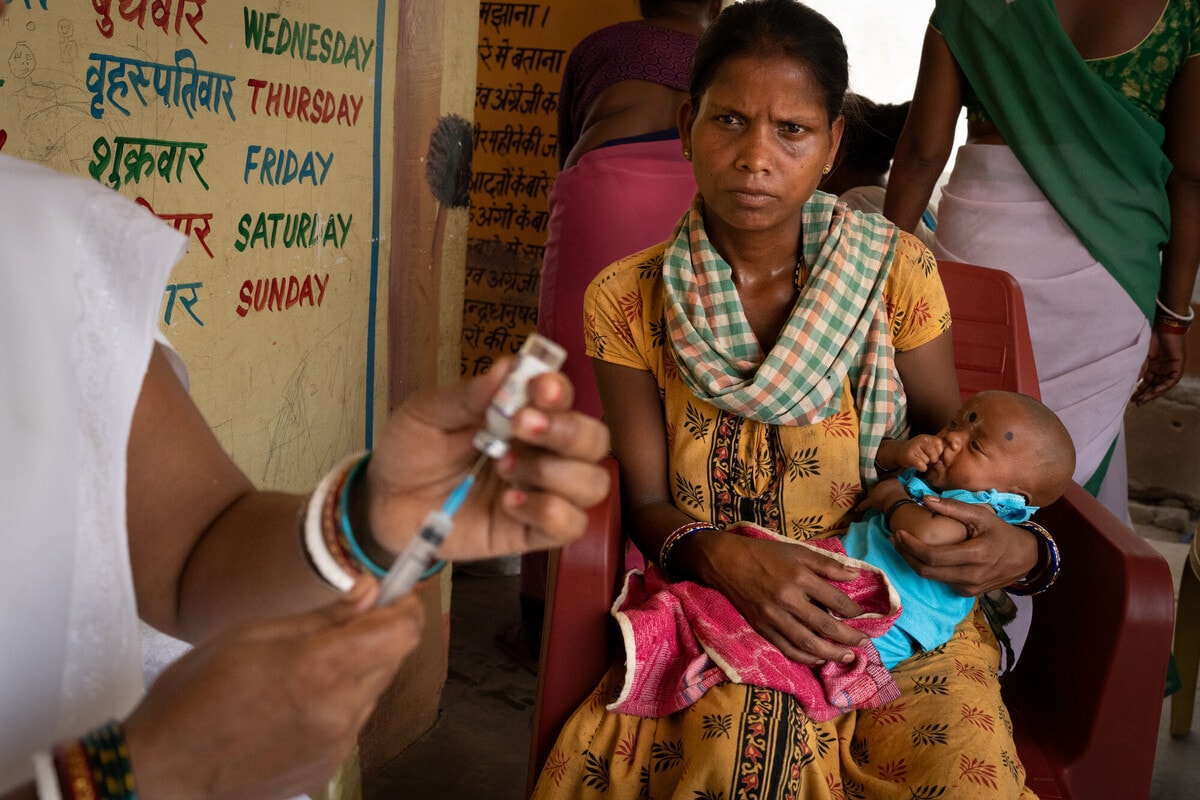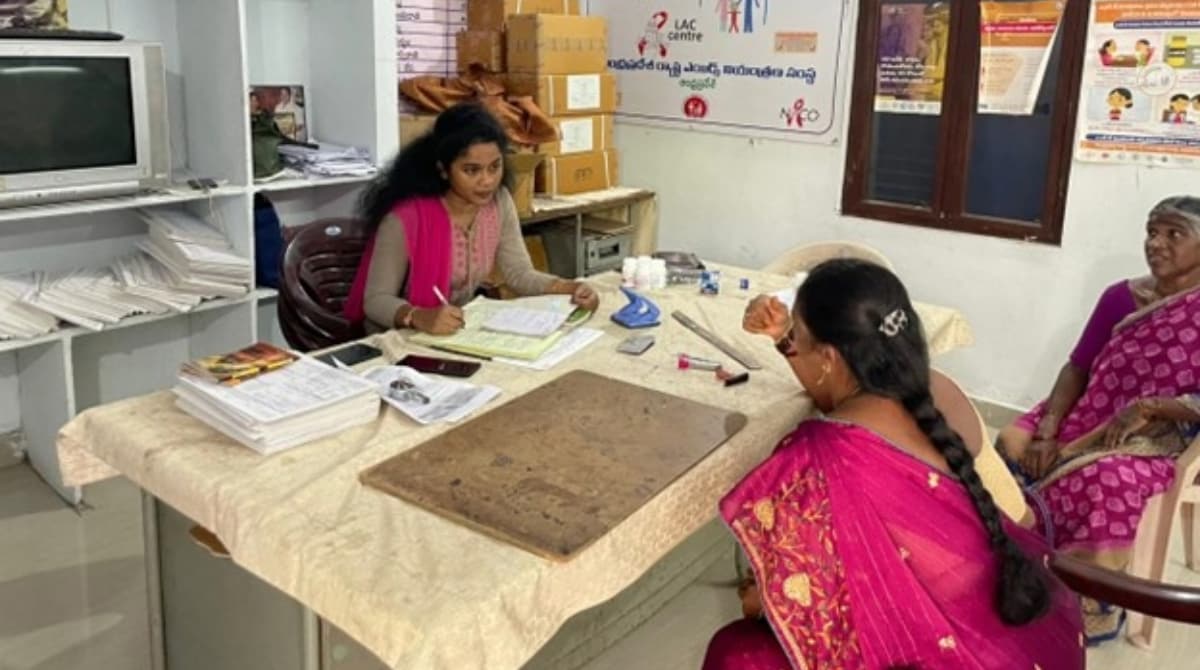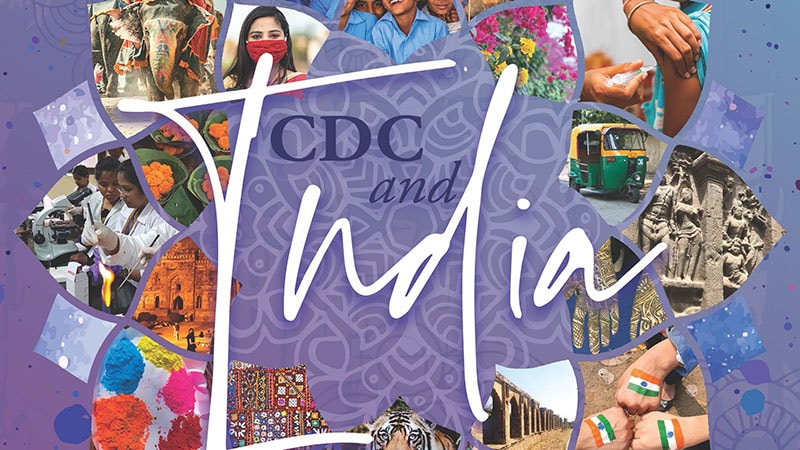At a glance
For over 50 years, CDC has engaged in technical collaboration with the Ministry of Health and Family Welfare to address public health priorities. As health threats emerge, CDC and national partners are prepared to leverage initiatives that strengthen global health security and respond to new public health challenges.

Overview

© UNICEF/U.S. CDC/UNI421369/Ahmad
As new health threats emerge, CDC and national partners are well-placed to leverage successful initiatives. Together they work to strengthen global health security capabilities and rapidly respond to new public health challenges.
Improving public health systems
CDC supports global health security priorities in India by providing technical expertise in strengthening public health systems to prevent, detect, and respond to emerging infectious diseases. Efforts include:
- Evidence-based technical guidance for Integrated Public Health Laboratory (IPHL)
- Leading One Health efforts to adapt training programs
- Prioritizing infectious disease implementation
- Strengthening surveillance and reporting for AMR
CDC has supported training for over 20,000 workers in epidemiology and disease surveillance, public health emergency management, laboratory diagnostic testing, and biosafety and quality management.
Laboratory systems
CDC is collaborating with Government of India (GoI) to develop a tiered lab network capable of detecting emerging and novel pathogens such as Nipah, influenza and others. CDC supports GoI initiatives to improve and serve as a regional leader in:
- Diagnostic capabilities
- Quality management systems
- Biosafety and biosecurity practices
- Specimen referral and transport
- Genomic surveillance
Key achievements
- Strengthened molecular detection capabilities for emerging pathogens.
- Developed and implemented IPHLs and their scale-up across all 730 districts. IPHLs have streamlined district and block level lab practices and increased lab diagnostic capacity.
- Trained in the application of evidence-based techniques for sub-district, district, and state referral labs.
- Supported the National Institute of Epidemiology to build capacity for whole genome sequencing of antimicrobial-resistant bacteria.
Workforce development
CDC's Field Epidemiology Training Program (FETP) strengthens the public health workforce's abilities to detect, respond, and control disease outbreaks at the source. To meet international health regulation targets, India needs to train over 7,000 epidemiologists. To help achieve this goal, CDC supported the establishment of an advanced FETP, India Epidemic Intelligence Service (India EIS) in 2012. Since then, India FETP has expanded to three hubs, training over 200 officers per year, across three FETP tiers (advanced, intermediate, and frontline). Since 2012, India FETP officers investigated over 550 outbreaks and conducted over 300 surveillance evaluations.
Key accomplishments
- Championed the development and release of a "One-India" FETP Roadmap, which lays the vision for FETP in India.
- Supported India FETP in launching two new initiatives to support FETP faculty development – an India EIS faculty cohort and a two-year public health workforce fellowship.
- Provided support to 'SectorConnect' (a One-Health Frontline FETP) and a one-year informatics program (Growing Experience in E-Learning and Knowledge, or GEEKS).
- Collaborated with GoI, WHO, and the South Asia Field Epidemiology Training Network to develop an India FETP learning management system platform. The platform will be instrumental in expanding a cadre of highly skilled field epidemiologists through a scalable learning approach.
Emergency management
CDC collaborates with GoI to enhance India's emergency management capabilities and resilience. Through national technical working groups, CDC provides technical assistance to implement modern emergency management concepts and principles, using a common framework for public health response, and exercises for pandemic preparedness. CDC aims to:
- Increase emergency management human resource capacity
- Strengthen national and sub-national emergency operations centers (EOCs)
- Develop and update emergency response plans, protocols, and procedures
- Build and sustain crisis and risk communication capacity
- Enhance points of entry preparedness and response capabilities
- Train and equip rapid response teams with management and operations competence
- Offer real-time support for multiple activations of EOCs and outbreak response systems
Key accomplishments
- Supported the establishment, operation, and management of national and sub-national EOCs that can coordinate and direct response to disease outbreaks, natural or humanmade disasters, and other public health emergencies.
- Collaborated to create, develop, establish, and maintain a comprehensive five-tiered Public Health Emergency and Disaster Management Professional Development Program. This program aims to develop preparedness and response capacity for the entire spectrum of the response workforce, from community members to professionals and policymakers.
- Support training for multisectoral personnel to effectively respond to public health emergencies and disasters, thereby fostering the development of a strong, adaptable, and resilient emergency management workforce.
Antimicrobial resistance (AMR)
CDC has been supporting the National Center for Disease Control (NCDC), GoI, to establish the National Antimicrobial Surveillance Network (NARS-NET) to improve quality assured testing, standardize scopes of practice, and conduct trainings. NARS-NET has increased from 10 laboratories in 2013 to include 50 laboratories across 27 states and 6 union territories.
CDC supports NCDC in strengthening the state level AMR surveillance networks. This support includes training and conducting reviews in seven Indian states. CDC supports AIIMS in partnership with the Indian Council for Medical Research to develop and implement a network for surveillance and prevention of healthcare associated infections.
Key accomplishments
- More than 200 intensive care units report to AIIMS. These reports include nearly 60 hospitals that conduct surveillance for bloodstream infections, urinary tract infections, and surgical site infections. An additional 40 medical college hospitals are enrolled through the NCDC, and 750 district hospitals across the country will be enrolled to the network.
- AIIMS prepares and and shares quarterly reports with Ministry of Health and Family Welfare (MoHFW) and key stakeholders, including WHO.
- Through CDC support, the network uses virtual training programs to build capacity to reduce HAIs and improve infection prevention and control programs using quality improvement methodology.
- Contribute to NCDC, GOI technical advisory and core working groups on AMR, infection prevention and control, and Antimicrobial Stewardship Program to develop and implement a National Action Plan on Antimicrobial Resistance.
HIV
In collaboration with GoI, CDC is improving access to comprehensive HIV prevention, testing, and treatment care continuum for priority and key populations. CDC efforts and key accomplishments are outlined below.
Prevention and case finding
- Integrated service delivery strategies by establishing community one stop centers, motor bike interventions, and service delivery strategies for people who migrate.
- Supported a free mobile application of the national HIV treatment guidelines.
- Expanded evidence-based case finding strategies, including index testing services, and social network strategy. These strategies have been included in the revised national HIV counseling and testing guidelines.
- Supported training for 430 master trainers in index testing services. These master trainers coordinated cascade trainings for over 5,772 healthcare workers (5,000 ICTC and 772 ART center staff.)
Treatment
- Influential in drafting the national operational guidelines for antiretroviral treatment (ART) services and national guidelines for HIV care and treatment. These guidelines were disseminated to staff from 772 ART centers and 29 state AIDS control societies.
- Developed a curriculum for training of antiretroviral therapy centre staff and trained a pool of 120 master trainers to cascade the training to staff from 772 centres.
- Partnered to integrate strategies that address non-communicable diseases for people living with HIV (PLHIV). This includes screening and management of cervical cancer, hypertension, diabetes and mental health, into HIV care to ensure treatment continuity.
- Supported demonstration of the full package of HIV Advanced Disease Management package (ADM) including point of care screening of TB and cryptococcus (a fungal infection.)
Lab strengthening
- Integrated diagnostic network strategies, network optimization, and workforce development to strengthen the HIV viral load test capacity to provide annual viral load tests to 1.4 million PLHIV receiving treatment at 772 ART centers.
- Supported technology transfer for the HIV-1 testing proficiency program with successful expansion to 64 molecular labs.
- Supported NACO's laboratory quality assurance and accreditation flagship program since 2009 and call for 100% of ISO 15189 accreditation for all the 250 HIV, viral load and early infant diagnosis labs.
- Provided technical assistance to strengthen the STI lab network across 10 regional sexually transmitted infections (STI) labs and provide quality assured etiological diagnosis and drug resistance profiling.
- Collaborated with NACO and Global Fund partners to develop HIV drug resistance diagnostic capacities in India.
- Demonstrated the full HIV Advanced Disease Management package, including point-of- care screening of TB and cryptococcus.
Strategic information
- CDC supports NACO's framework for integrated and enhanced epidemiology and surveillance for HIV, STIs, and comorbidities. This includes support for HIV estimates, India's nationwide HIV behavioral sentinel surveillance — the largest in the world— and integrated biological and behavioral surveillance among key populations.
TB
CDC supports the National Tuberculosis Elimination Program (NTEP) to end TB by supporting four strategic pillars: detect, treat, prevent, and strengthen capacity. CDC efforts and key accomplishments are outlined below.
Prevention and treatment
CDC successfully implemented "Strengthening TB Action and Response (STAR)" project in Mumbai to:
- Provide public sector drug susceptibility testing support to start individualized drug-resistant TB (DR TB) treatment
- Improve DR TB treatment adherence
- Strengthen TB infection prevention and control (IPC) practices to reduce TB transmission at 144 healthcare facilities
This work was successfully scaled up in ten states as the 'TB Mukt Bharat IPC' project. The project is being implemented in 189 healthcare facilities in 63 districts across ten states of India.
- Implemented the 'PrTHAM' project to prevent TB infection among healthcare workers through screening for TB and TB infection at Mahatma Gandhi Institute of Medical Sciences and Kasturba hospital in Sevagram, Maharashtra.
- During the COVID-19 pandemic, CDC-supported Dharavi project that improved treatment outcomes among patients with DRTB in Mumbai's informal urban settlements. The project retained nearly all patients on treatment, even those who migrated elsewhere.
- Implemented early TB preventive treatment programs in India to diagnose and treat TB among household contacts in Nagpur and Mumbai, Maharashtra, using patient-friendly diagnostic tests and treatment regimens.
- Supported NTEP to improve linkage to TB evaluation and treatment in children through the 'End TB in Indian Children' project in Delhi, Mumbai, and Chennai.
- Provided technical support to ensure external quality assessment for rapid molecular tests. The NTEP plans eventually expanded the practice to cover all TB testing sites in India.
- Provided capacity for next generation sequencing at the National Institute of Research in TB (NIRT) in Chennai. With CDC support, NIRT conducted NGS on a prospective cohort of patients with DR TB across India. This effort identified common and new TB mutations and led to the first Indian TB catalogue of mutations.
Data management
- Expanded ELEVATE (E2) project to strengthen state- and district-level capacity to use local data to guide programmatic actions and accelerate TB control and elimination efforts in 11 states across India.
- Supported training a total of 767 NTEP staff across the states on data quality and analysis to support states' management for information to programmatic action.
Influenza
CDC helps India prepare for pandemics in alignment with India's "Pandemic Influenza Preparedness and Response Plan". CDC works to strengthen laboratories and training clinicians on effective case management and infection control. Strong influenza surveillance has enabled India to detect influenza seasonal peaks during monsoons, understand the seasonality of influenza in tropical countries, and guide timing for influenza vaccination.
Key accomplishments
- Collaborated with the All India Institute of Medical Sciences (AIIMS) to help determine the disease and economic burdens of influenza and other respiratory viruses in priority groups, evaluate effectiveness of influenza vaccines, and identify optimal timing for influenza vaccination.
- Fostered collaboration in influenza prevention and control among diverse stakeholders, including government bodies, healthcare professionals, researchers, and professional organizations in India through multiple stakeholder meetings during 2022-23 period involving representatives from more than 15 states.
- Advanced molecular diagnostic capacity developed during CDC's collaborations with National Institute of Virology. Efforts were made to scale up PCR SARS-CoV-2 testing across India's influenza laboratory network.
- Strengthened the influenza surveillance network by building lab capacity for rapid detection of viruses and emerging pathogens. This includes building capacity for molecular diagnostics (RT-PCR and genetic sequencing) and providing critical supplies.
- Supported trainings on Flu-COVID-19 RT-PCR and NGS for participants from medical colleges across India regions (Karnataka, Kerala, Andhra Pradesh, Rajasthan, Madhya Pradesh, Jammu & Kashmir, West Bengal, Sikkim, Meghalaya, and Assam).
Vaccine-preventable diseases (VPDs)
CDC supports efforts to eliminate or control vaccine-preventable diseases through the Universal Immunization Program. Since the mid 1990's, CDC has helped strengthen:
- Epidemiology and laboratory methods
- Routine immunization services
- Training methods, data systems
- Case-based disease surveillance
- Outbreak preparedness and response
CDC's support of the National Public Health Surveillance Project strengthened implementation of polio, measles, and COVID-19 vaccination campaigns, outbreak response, and surveillance.
Success story spotlight
Empowering community leaders among female sex workers for HIV service equity and addressing stigma

CDC India, in collaboration with the Society for Health Allied Research and Education INDIA (SHARE INDIA) and the Andhra Pradesh State AIDS Control Society (APSACS) worked to enhance HIV service delivery for female sex workers at NARI SAKSHAM, a community led organization in Rajahmundry, Andhra Pradesh. This organization reaches 2,700 female sex workers across the district through 100 community-based groups.
Female sex workers have historically faced barriers in health care settings such as social exclusion, stigma, and discrimination. Additionally, a complex public health system with limited accessibility has led to poor patient outcomes, including irregular pick up of antiretroviral treatment (ART), lack of follow up, and lower adherence to treatment.
To improve access to HIV treatment among female sex workers living with HIV, CDC provided on-site technical assistance to NARI SAKSHAM for establishing decentralized ART clinical services to ensure consistent treatment and durable viral load suppression. CDC trained community leaders on how to administer ART, regularly check on people living with HIV, collect samples for viral load tests, and report data. Through the Undetectable = Untransmittable (U=U) campaign, community leaders also promoted positive HIV treatment adherence and reducing stigma.
G. Vijaya Rani, coordinator at NARI SAKSHAM, noted significant improvements: 981 people living with HIV, including 412 female sex workers received regular ART. "Earlier we didn't know if members were taking medicines regularly and if their health was okay. Now I can observe that they come regularly and take ART. I am also able to follow up on their VL test due dates and refer them for tests on time".
From 2020 to 2022, the initiative achieved a 98% treatment retention rate for female sex workers with HIV, increased viral load testing access from 21% to 92%, and improved viral suppression from 77% to 94%. This model's success led to its adoption by 29 community-based organizations across Andhra Pradesh, setting a national benchmark for empowering communities and achieving HIV service equity.

